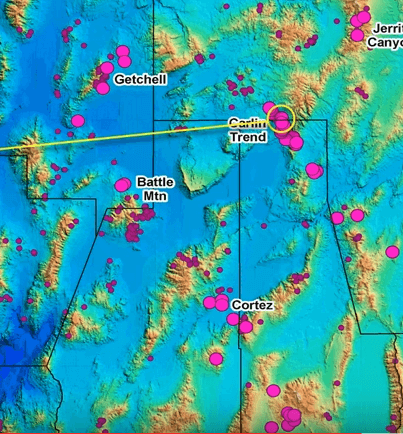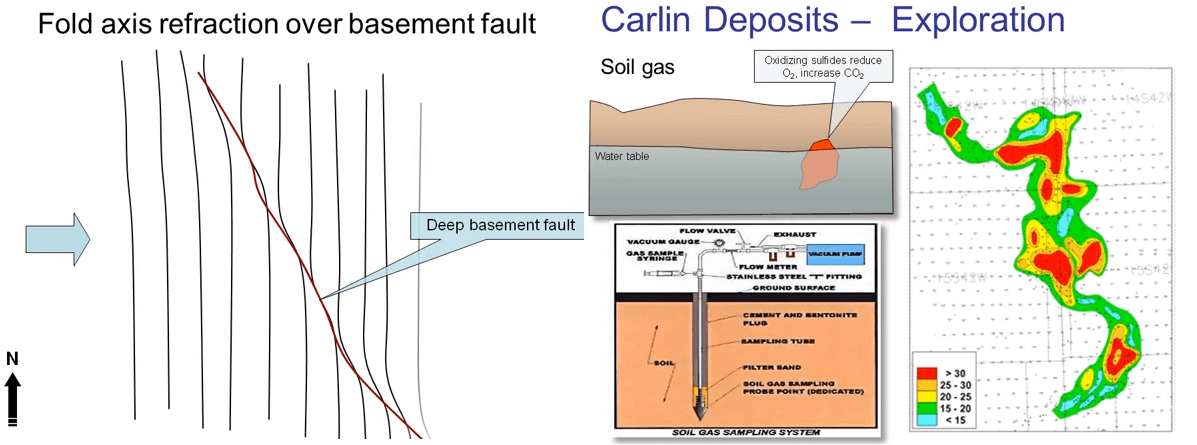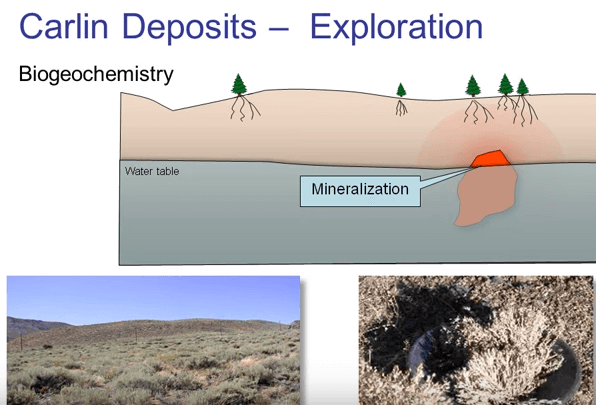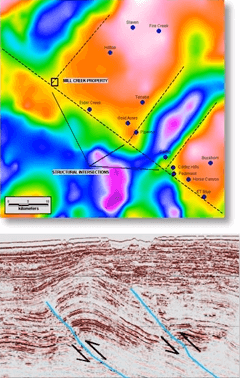
 Now let’s turn to exploration Carlin Type Gold System: This is the image that I showed earlier of the topography of Northern Nevada with the location of Carlin deposits marked, note how most of the deposits that are being discovered to date are either in the ranges or clustered along the edges of the flat bottom valleys where gravel cover is thin. Exploration for Carlin deposits occurred in a number of phases; early exploration focused on areas where the favorable lower plate carbonate rocks are cropped at surface and sulfide mineralization have been completely oxidized. The next phase of exploration focused on deeper sulfide portions of known deposits then the explorers stepped out to look under shallow cover of upper plate or younger gravels but now most of the low hanging fruits have been picked and were entering an even more challenging phase where the exploration is turning to blind deposits and the deep gravels and upper plate rocks. This is where the next the group of deposits are likely to be found but the bar is much higher for these given the cost of deep exploration drilling and the need for higher gold grades that will support deeper underground mining and completely un-oxidized ores. During the first phase of Carlin exploration in the 1970’s much exploration was simply drilling 30 meter RC holes along arc cropping structures. Such holes cost less than $1000 each. Today’s exploration however requires 1000 meter diamond drill holes that cost a $250,000 each and it doesn’t take many of those to exhaust a junior explorers finances but fortunately since those early days we’ve learned to be much smarter and more surgical in our exploration and future exploration will require an even better understanding of both the genesis and the controls of mineralization.
Now let’s turn to exploration Carlin Type Gold System: This is the image that I showed earlier of the topography of Northern Nevada with the location of Carlin deposits marked, note how most of the deposits that are being discovered to date are either in the ranges or clustered along the edges of the flat bottom valleys where gravel cover is thin. Exploration for Carlin deposits occurred in a number of phases; early exploration focused on areas where the favorable lower plate carbonate rocks are cropped at surface and sulfide mineralization have been completely oxidized. The next phase of exploration focused on deeper sulfide portions of known deposits then the explorers stepped out to look under shallow cover of upper plate or younger gravels but now most of the low hanging fruits have been picked and were entering an even more challenging phase where the exploration is turning to blind deposits and the deep gravels and upper plate rocks. This is where the next the group of deposits are likely to be found but the bar is much higher for these given the cost of deep exploration drilling and the need for higher gold grades that will support deeper underground mining and completely un-oxidized ores. During the first phase of Carlin exploration in the 1970’s much exploration was simply drilling 30 meter RC holes along arc cropping structures. Such holes cost less than $1000 each. Today’s exploration however requires 1000 meter diamond drill holes that cost a $250,000 each and it doesn’t take many of those to exhaust a junior explorers finances but fortunately since those early days we’ve learned to be much smarter and more surgical in our exploration and future exploration will require an even better understanding of both the genesis and the controls of mineralization.  This image illustrate the main features of Carlin deposits they tend to form on all faults that have been reactivated during ascension. They are usually associated with anticlines that form during the earlier compression particularly those that formed above thrust faults. Dirty limestone units provide the best host and they are often especially associated earlier intrusive that fracture the host rocks allowing the fluid to penetrate more widely.
This image illustrate the main features of Carlin deposits they tend to form on all faults that have been reactivated during ascension. They are usually associated with anticlines that form during the earlier compression particularly those that formed above thrust faults. Dirty limestone units provide the best host and they are often especially associated earlier intrusive that fracture the host rocks allowing the fluid to penetrate more widely.
So how can we use the knowledge of these controls to design exploration programs? Well let’s look at the faults first; one way we can do it is to learn to recognize the old faults with the longest history of movement as those are the ones that are likely to provide deep tapping channel waves for the mineralizing fluids but with the myriad of faults crisscrossing in an area how do we recognize which of the old faults as opposed to the younger ones which may be irrelevant to the story.  Well there are several ways; here is a cartoon section of a fault that was actively moving during sedimentation and long before mineralization came in and we can identify these old faults by the presence of linear limestone reef material along the fault edge or the existence of changes of sedimentary stratigraphy such is the change in thickness of sedimentary unit across the faults or by the presence of exhalative barite or exhalative sulfides or even sedimentary rock along the fault. Recognizing any of these features while mapping can help differentiate these old faults that we are really interested in but sometimes the critical feeder fault in the lower plate may be completely hidden by the over thrust upper plate rocks.
Well there are several ways; here is a cartoon section of a fault that was actively moving during sedimentation and long before mineralization came in and we can identify these old faults by the presence of linear limestone reef material along the fault edge or the existence of changes of sedimentary stratigraphy such is the change in thickness of sedimentary unit across the faults or by the presence of exhalative barite or exhalative sulfides or even sedimentary rock along the fault. Recognizing any of these features while mapping can help differentiate these old faults that we are really interested in but sometimes the critical feeder fault in the lower plate may be completely hidden by the over thrust upper plate rocks.
 So how can we detect these hidden lower faults? Well the old fault in the lower plate when it is reactivated during thrusting tends to form a step and this will tend to trip up the upper plates as it is pushed over it warping the fault axis. So changes in the orientation of fault hinges in the upper plate rocks may therefore indicate the presence of potential feeder faults hidden in the lower plate rocks. Geochemistry can also be used to detect leakage from blind ore deposits. This geochemistry can detect trace levels of gold or arsenic or evidence of oxidizing sulfides. The sample mediums that are collected can include soils or soil gas or even vegetation; most successful gas technique looks for changes in the ratio of oxygen to carbon dioxide caused by buried oxidizing sulfides absorbing the oxygen and is a byproduct producing acid that attacks the limestone to produce carbon dioxide. So the image on the right hand side shows a plan over a known deposit and it shows the enrichment of CO2 relative to oxygen. In vegetation sampling vegetation such as sagebrush can trap the metals on the groundwater that it absorbs.
So how can we detect these hidden lower faults? Well the old fault in the lower plate when it is reactivated during thrusting tends to form a step and this will tend to trip up the upper plates as it is pushed over it warping the fault axis. So changes in the orientation of fault hinges in the upper plate rocks may therefore indicate the presence of potential feeder faults hidden in the lower plate rocks. Geochemistry can also be used to detect leakage from blind ore deposits. This geochemistry can detect trace levels of gold or arsenic or evidence of oxidizing sulfides. The sample mediums that are collected can include soils or soil gas or even vegetation; most successful gas technique looks for changes in the ratio of oxygen to carbon dioxide caused by buried oxidizing sulfides absorbing the oxygen and is a byproduct producing acid that attacks the limestone to produce carbon dioxide. So the image on the right hand side shows a plan over a known deposit and it shows the enrichment of CO2 relative to oxygen. In vegetation sampling vegetation such as sagebrush can trap the metals on the groundwater that it absorbs.
 Collecting sagebrush samples on a grid and reducing them to ash and then assaying that ash has been used to identify buried mineralization in certain cases. Geophysics also plays a valuable role in Carlin exploration; magnetics can be used to identify hidden faults and intrusives. Gravity can identify shallow gravel cover in the valleys and hidden displacements of the lower plate rocks and hence possibly feeder faults along the edge of those displacements. It can also detect de-calcification in limestones caused by the acidic gasses that accompanied and form around the mineralizing fluids. Seismic surveys concede displacements long hidden faults as well as anticline or fluid traps and favorable host horizons.
Collecting sagebrush samples on a grid and reducing them to ash and then assaying that ash has been used to identify buried mineralization in certain cases. Geophysics also plays a valuable role in Carlin exploration; magnetics can be used to identify hidden faults and intrusives. Gravity can identify shallow gravel cover in the valleys and hidden displacements of the lower plate rocks and hence possibly feeder faults along the edge of those displacements. It can also detect de-calcification in limestones caused by the acidic gasses that accompanied and form around the mineralizing fluids. Seismic surveys concede displacements long hidden faults as well as anticline or fluid traps and favorable host horizons.
Summarize the top targeting criteria of Carlin Type Gold System Exploration would look something like this:
- Focus exploration in the Carlin or Cortez corridors
- Stay within 500 meters of long-lived inverted crustal scale faults usually within a kilometer vertically of the Roberts Mountain thrust and usually below it rather than above in the lower plate rocks in other words
- Within a kilometer of Eocene intrusions and possibly even older cretaceous intrusions.
- In fault related hanging wall anticlines and these may display abundant black carbon
- In dirty carbonate host rock usually but not always in the lower plates showing de-calcification i.e. a gravity low.
There will undoubtedly be some Carlin deposits that don’t have all these features but the majority of the deposits will exhibit most of them.
